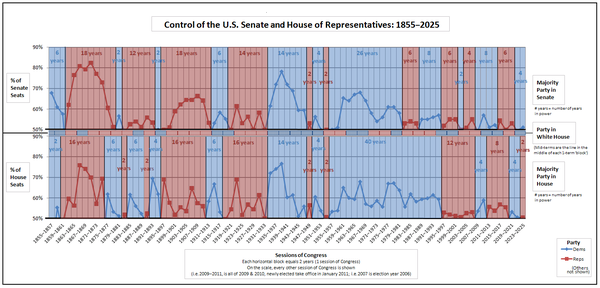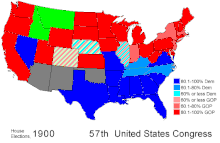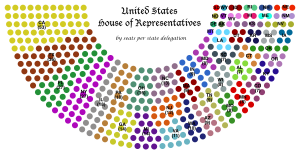What Is the Total Number of Representatives in the House

The United States House of Representatives, commonly known equally the lower chamber of the Usa Congress, along with the The states Senate, commonly known as the upper chamber, are the two parts of the legislative co-operative of the federal government of the Us. Like its counterpart, the House was established past the United states of america Constitution and convened for its get-go meeting on March iv, 1789, at Federal Hall in New York City. The history of this institution begins several years prior to that date, at the dawn of the American Revolutionary State of war.
The Continental Congresses [edit]
The Beginning Continental Congress was a meeting of representatives of twelve of Britain's seventeen North American colonies, in the autumn of 1774. The Continental Congress sent a listing of grievances to Male monarch George Iii. When the King failed to respond, and the American Revolutionary War began in April 1775, the Second Continental Congress was convened—this fourth dimension with thirteen colonies in attendance. A year later on, on July 4, 1776, the Continental Congress alleged the thirteen colonies free and independent states, referring to them as the "the states." This was not a formal proper noun, notwithstanding, then "united" was non capitalized in the Declaration of Independence, "States" being capitalized only considering all nouns were capitalized in English language earlier the Industrial Revolution. The Second Continental Congress connected in office while the State of war for Independence continued, producing the Articles of Confederation— the state'southward first constitution— in 1777, which was ratified by all of u.s.a. past 1781.
Articles of Confederation and new Constitution [edit]
Under the Articles of Confederation, the Congress of the Confederation was a unicameral body in which each country was equally represented, and in which each land had a veto over most action. States could, and did, ignore what did pass. The ineffectiveness of the federal government nether the Manufactures led Congress to summon the Convention of 1787.
One of the near divisive bug facing the Convention was the construction of Congress. James Madison'due south Virginia Plan chosen for a bicameral Congress; the lower house would be elected directly by the people, and the upper business firm would be elected by the lower firm. The program drew the support of delegates from large states such as Virginia, Massachusetts, and Pennsylvania, every bit it called for representation based on population. The smaller states, nevertheless, favored the New Jersey Program, which called for a unicameral Congress with equal representation for the states. Eventually, a compromise, known equally the Connecticut Compromise or the Keen Compromise was reached; one house of Congress (the House of Representatives) would provide proportional representation, whereas the other (the Senate) would provide equal representation. The Constitution was ratified by the finish of 1788, and its full implementation was set for March 4, 1789.
18th century [edit]
The House of Representatives began work on April i, 1789, when it achieved a quorum for the first time,[1] with 59 members elected from xi states. In 1790, N Carolina and Rhode Island elected representatives (see: 1788 and 1789 Us House of Representatives elections), bringing the total count of representatives to 65.[ii] [3] [4]
In the 1st Usa Congress, Frederick Muhlenberg, a Pennsylvania Lutheran minister and politician, was the outset Speaker of the House.
19th century [edit]
The early 19th century was marked by the assertion of Congress' gradual independence from the Presidency starting from the presidency of James Madison and onward. The Firm became the preeminent establishment in Congress, originally overshadowing the Senate. For most of the commencement half of the 19th century, a balance between the free North and the slaveholding Southward existed in the Senate, equally the numbers of complimentary and slave states were equal. Yet, since the North was much more populous than the S, information technology dominated the Firm of Representatives. In 1825, new Speaker of the House Henry Clay also officially announced that he and his followers would divide from Andrew Jackson and class the National Republican Party. Clay lost to Jackson in the 1832 presidential election and moved to the Senate.

Historical graph of party control of the Senate and House too every bit the Presidency
[5]
During the Civil War, the key policy-maker in Congress was Thaddeus Stevens, every bit chairman of the Means and Ways Committee and as Republican flooring leader. He took charge of major legislation that funded the war try and revolutionized the nation'due south economic policies regarding tariffs, bonds, income and excise taxes, national banks, suppression of money issued by state banks, greenback currency, and western railroad land grants.[6]
Stevens was too one of the major policymakers regarding Reconstruction, and obtained a Business firm vote of impeachment against President Andrew Johnson (who was acquitted by the Senate in 1868). Hans Trefousse, his leading biographer, concludes that Stevens "was one of the most influential representatives ever to serve in Congress. [He dominated] the Firm with his wit, noesis of parliamentary police force, and sheer willpower, even though he was ofttimes unable to prevail."[7] Historiographical views of Stevens accept dramatically shifted over the years, from the early 20th-century view of Stevens and the Radical Republicans every bit tools of large business and motivated by hatred of the white South, to the perspective of the neoabolitionists of the 1950s and subsequently, who applauded their efforts to requite equal rights to the freed slaves.
The Democrats were a weak minority from 1861 to 1874, and so made a major comeback in 1874 by winning 93 seats held past the GOP and becoming the majority. The Gilt Age was marked by close balances in the House, with the parties alternating command.
Between 1860 and 1920 the average tenure of House members doubled from four to eight years. This number reflects the growth of "congressional careerism." The Firm began to develop a more stable culture, sessions of the House became longer, and members of the House began to specialize in specific areas of policy. Power was decentralized from the Speaker of the House, and seniority about assured advancement inside the Business firm. The increasing importance of the federal government, an increasing acceptance of lengthy congressional service, and (subsequently 1896) a refuse in the partisan competitiveness of congressional districts all contributed to the growing length of the boilerplate term of House members.[viii]
20th and 21st-centuries [edit]

Business firm of Representatives 1900-48
The early 20th century witnessed the rise of party leadership in both houses of Congress. In the House of Representatives, the office of Speaker became extremely powerful, reaching its zenith nether the Republican Joseph Gurney Cannon. In detail, committee chairmen remained particularly strong in both houses until the rules reforms of the 1970s.
On Nov 7, 1916, Jeannette Rankin was elected to Montana'southward at-large seat in the House of Representatives, becoming the first female member of Congress.[nine] In 1973 Speaker of the House Carl Albert appointed Felda Looper as the offset female folio in the House of Representatives.[10]
After the starting time of the Great Depression and the New Deal, the Democrats controlled the Business firm from 1931 to 1994, with ii exceptions (1946 and 1952), as the New Deal Coalition was successful. In terms of legislation, however, the Bourgeois coalition ordinarily blocked liberal legislative proposals, except in 1964–65 when President Lyndon Johnson had the majorities to pass his Peachy Society proposals. The nearly important leader was long-fourth dimension Democratic Speaker Sam Rayburn. The Republicans nether Newt Gingrich returned to a majority in the election of 1994, as part of the Republican Revolution that gave the party both houses and a majority of governorships that year.
The Democrats gained 30 seats in the 2006 elections, regaining control and electing Nancy Pelosi as the get-go female Speaker. They strengthened their control during the 2008 elections, gaining an additional 21 seats. However, the Republicans before long erased those gains later gaining 63 seats in the 2010 elections, the largest seat change for any ballot since 1948. Republican control of the firm remained until the 2022 elections.
Number of Representatives [edit]

Size of House of Representatives 1789–2009

The 435 seats of the House grouped by state
Congress has the power to regulate the size of the House of Representatives, and the size of the Business firm has varied through the years in response to the access of new states, reapportionment following a demography, and the Civil War.[11]
| Year | 1789 | 1791 | 1793 | 1803 | 1813 | 1815 | 1817 | 1819 | 1821 | 1833 | 1835 | 1843 | 1845 | 1847 | 1851 | 1853 | 1857 |
|---|---|---|---|---|---|---|---|---|---|---|---|---|---|---|---|---|---|
| Representatives | 65 | 69 | 105 | 141 | 182 | 183 | 185 | 187 | 213 | 240 | 242 | 223 | 225 | 227 | 233 | 234 | 237 |
| Year | 1861 | 1863 | 1865 | 1867 | 1869 | 1873 | 1883 | 1889 | 1891 | 1893 | 1901 | 1911 | 1913 | 1959 | 1961 | 1963 |
|---|---|---|---|---|---|---|---|---|---|---|---|---|---|---|---|---|
| Representatives | 178 | 183 | 191 | 193 | 243 | 293 | 325 | 330 | 333 | 357 | 386 | 391 | 435 | 436 | 437 | 435 |
In 1911, Congress passed the Circulation Deed of 1911, also known as 'Public Law 62-5', which capped the size of the United states of america House of Representatives at 435 seats.[12] [13] Arizona, New Mexico, Alaska, and Hawaii were each granted one representative when they first entered the union. During the adjacent reapportionment, the size of the Business firm was once more limited to 435 seats, with the seats divided among the states by population, with each country getting at least 1 seat.
By the 2000s, the U.S. population had more tripled since the 1911 expansion of the Firm to its current 435 seats; accordingly, proposals began to be made by commentators such every bit George F. Will, Robert Novak, and Paul Jacob to further increase the size of the House.[14] Ane such proposal, the Wyoming Dominion, calls for adding enough members to Congress to reduce the population of the average Congressional district to the population of the to the lowest degree populous land'southward smallest district; in 1990, this would have resulted in a total House size of 547.
References [edit]
- ^ United States House of Representatives
- ^ Lampi, Philip. "Firm of Representatives, 1787–1789". Tufts Digital Library, Tufts Academy.
- ^ Bickford, Charlene Bangs, and Bowling, Kenneth R., Birth of the nation: the First Federal Congress, 1789–1791 (Rowman & Littlefield, 1989)
- ^ Christman, Margaret C.S., The Offset Federal Congress, 1789–1791 (Smithsonian Establishment Press, 1989.)
- ^ "Party In Power – Congress and Presidency – A Visual Guide To The Balance of Power In Congress, 1945–2008". Uspolitics.most.com. Archived from the original on November 1, 2012. Retrieved September 17, 2012.
- ^ Heather Cox Richardson (1997). The Greatest Nation of the Earth: Republican Economical Policies During the Civil War. Harvard Academy Press. pp. ix, 41, 52, 111, 116, 120, 182, 202. ISBN9780674059658.
- ^ Hans 50. Trefousse (1991). Historical Dictionary of Reconstruction. Greenwood. p. 214. ISBN9780313258626.
- ^ Kernell, Samuel (November 1977). "Toward Understanding 19th Century Congressional Careers: Ambition, Contest, and Rotation". American Journal of Political Science. 21 (4): 669–693. doi:x.2307/2110731. JSTOR 2110731.
- ^ "Jeannette Rankin". Women in Congress. Archived from the original on November iii, 2010. Retrieved January x, 2013.
- ^ "Lincoln Evening Periodical from Lincoln, Nebraska · Page 103". Newspapers.com. June 17, 1973. Archived from the original on February 15, 2015. Retrieved February xv, 2015.
- ^ Galloway, George B.; Sidney Wise (1976). History of the House of Representatives . Crowell. ISBN0-690-01101-half-dozen.
- ^ Pub.Fifty. 62–5, 37 Stat. 13
- ^ "Archived copy" (PDF). Archived (PDF) from the original on August thirteen, 2011. Retrieved September 12, 2011.
{{cite web}}: CS1 maint: archived re-create as title (link) - ^ America has outgrown the Firm of Representatives Archived February 7, 2008, at the Wayback Machine, Matthew Cossolotto, November 21, 2001.
Farther reading [edit]
- American National Biography (1999), contains biographies of all politicians no longer alive.
- Alexander, De Alva Stanwood. History and Procedure of the House of Representatives (1916) Alva Stanwood Alexander&dcontributors=De%20Alva%20Stanwood%20Alexander online edition
- Barone, Michael, and Grant Ujifusa, The Almanac of American Politics 1976: The Senators, the Representatives and the Governors: Their Records and Election Results, Their States and Districts (1975).
- Davidson, Roger H., and Walter J. Oleszek, eds. (1998). Congress and Its Members, sixth ed. Washington DC: Congressional Quarterly. (Legislative process, informal practices, and member data)
- Roger H. Davidson, Susan Webb Hammond, Raymond W. Smock, eds; Masters of the Business firm: Congressional Leadership over Two Centuries Westview Press, 1998 online edition
- Galloway; George B. History of the House of Representatives (1962) online edition
- Green, Matthew N. The Speaker of the Business firm: A Study of Leadership (Yale University Press; 2010) 292 pages; Examines partisan pressures and other factors that shaped the leadership of the speaker of the U.South. House of Representatives; focuses on the period since 1940.
- Hunt, Richard. (1998). "Using the Records of Congress in the Classroom," OAH Magazine of History, 12 (Summer): 34–37.
- MacNeil, Neil. Forge of Democracy: The House of Representatives (1963) popular history by a journalist
- Remini, Robert V. The Business firm: The History of the House of Representatives (2006) standard scholarly history
- Ritchie, Donald A. (1997). "What Makes a Successful Congressional Investigation." OAH Magazine of History, 11 (Bound): 6–8.
- Wilson, Woodrow. (1885). Congressional Government.
- Zelizer, Julian E. On Capitol Colina: The Struggle to Reform Congress and its Consequences, 1948–2000 (2004)
- Zelizer, Julian Eastward. ed. The American Congress: The Edifice of Democracy (2004), essays past leading scholars
- Zelizer, Julian E. "Burning Down the House: Newt Gingrich, the Fall of a Speaker, and the Rise of the New Republican Party (Penguin, 2020), focus on Jim Wright and Newt Gingrich in 1990s.
See also [edit]
- History of the United States Senate
- Party divisions of United states Congresses
Source: https://en.wikipedia.org/wiki/History_of_the_United_States_House_of_Representatives
0 Response to "What Is the Total Number of Representatives in the House"
Post a Comment